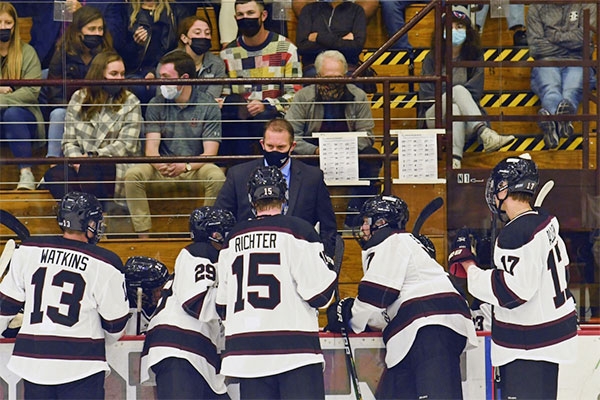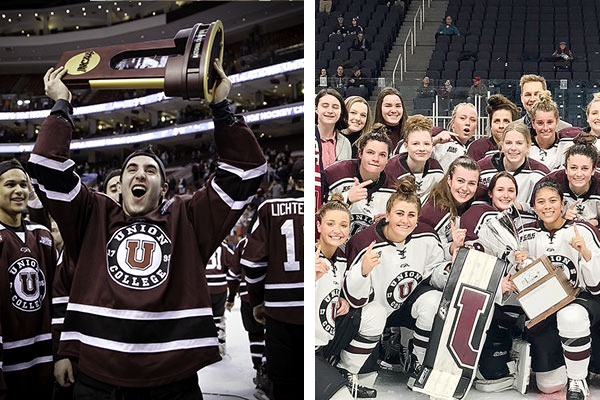It was 10:20 p.m. on Saturday, April 12. Gloves, sticks and confetti littered the ice in the Wells Fargo Center in Philadelphia.
Moments before, the last seconds had ticked away in the final of the men’s ice hockey game of the 2014 Frozen Four between Union and Minnesota. The transformation from Union’s club program, started in 1903, to a Division I national champion was complete.
Boisterous chants of “Let’s go U” filled the arena, echoed 250 miles away from fans who packed Messa Rink to watch the ESPN broadcast on a big screen. Later that week, a victory parade began near the rink and wound its way for over a mile through city streets lined three and four deep with supporters.
“What a great day for our community, and what a great day for Union College,” Schenectady Mayor Gary McCarthy said from the steps of City Hall, decorated with two huge banners, “Go Union.”
By defeating traditional hockey powers Boston College and Minnesota, Union, with an enrollment of only 2,200 students, captivated college hockey fans nationwide with headlines of its feat coast-to-coast, broadcasts that reached millions and social media that trended worldwide.
A key part of the storyline focused on the fact that Union’s success came without the benefit of offering athletic scholarships to its players. The only other schools to win a national championship in hockey without athletic scholarships? Harvard, Yale and Cornell.
Eight years later, though, the shifting dynamics in college sports has upended the competitive landscape. The new rules could make it difficult for multi-divisional schools like Union (which play Division I men’s and women’s ice hockey but compete in Division III in all other sports) to replicate that magical 2014 season.
One of the biggest changes came last spring, when the NCAA loosened its transfer rules, making it far easier for all college athletes to transfer one time without having to sit out a season. The exception to transfer from one Division I school to another had been available to athletes in other college sports for years, but the change meant it now applied to football, men’s and women’s basketball, men’s ice hockey and baseball.
The policy instantly put Union at a distinct disadvantage. Union’s hockey program prides itself on its ability to fill its rosters with solid players who are also exceptional students during their four years. Now, recruits could spend a year at Union getting valuable game experience before entering the transfer portal and be poached by a school that offers scholarships.
As President David R. Harris observed at a recent College town hall meeting, “If nothing changes, it is all too easy to imagine other Division I programs saying, ‘Great job finding that recruit, Union. We’ll take it from here.’’’
The College now hopes to level the playing field.
Union and the Rochester Institute of Technology - the only other school of the 59 competing in Division I hockey that is not allowed to offer scholarships -- recently petitioned the NCAA for a waiver that would allow them to offer scholarships.
The full Division III membership body will hold a legislative vote when it meets in Indianapolis Jan. 22.
The petition has the support of all NCAA Division I member conferences that sponsor men and women’s ice hockey, along with the American Hockey Coaches Association, Hockey Commissioners Association and Liberty League. The groups argue that the waiver protects the competitive spirit of the sport and abides by one of the association’s core tenets outlined in the NCAA’s Principle for Competitive Equity.
Supporters also point to the recent Supreme Court decision in Alston v. NCAA, which unanimously ruled that the NCAA could not restrict educational-related benefits including athletic scholarships and the cost of attendance.
“We are simply looking to provide the opportunities to our student-athletes and programs consistent with the Division I hockey landscape,” said Director of Athletics Jim McLaughlin ’93.
Currently, 10 NCAA schools compete primarily in Division III but also offer a sport at the Division I level. Of those, five offer scholarships, including four with hockey programs: Clarkson University, Colorado College, Rensselaer Polytechnic Institute and St. Lawrence University. The other multi-divisional institution that offers scholarships is Johns Hopkins University for men and women’s lacrosse.
If the vote at the upcoming NCAA convention overturns the current legislation, the five prohibited from offering scholarships at the Division I level can join them if they choose. Besides Union and RIT for hockey, the other schools are Franklin and Marshall (men’s wrestling), Hobart and William Smith College (men’s lacrosse) and Massachusetts Institute of Technology (women’s crew).
“Providing equitable opportunities to all of these institutions would better align with the NCAA’s principle of competitive equity,” McLaughlin said. He plans to attend the meeting in Indianapolis, along with President Harris.
The pending vote by the NCAA is arguably the most pivotal moment in the history of ice hockey at Union since the decision in 1991 for the men’s team to jump from Division III to Division I (the women moved to Division I in 2003). At the time, then-President Roger Hull agreed to the change, but he was adamant that the College would not offer scholarships. He believed that if the Ivy League schools could field competitive teams without the benefit of scholarships, so could a highly selective college such as Union.
College officials say that approach is no longer sustainable with the significant changes seen in the NCAA and Division I college hockey landscape.
After a rough beginning (the team went 6-43-1 in its first two seasons in Division I and posted 10 consecutive seasons with a winning percentage of .500 or worse from 1997 to 2007), the men’s program is now among the most successful in ECAC Hockey, boasting the second-most wins and third-highest winning percentage since the 2010 season.
Competing in the top hockey conference in the country (three national champions and three national runners-up in the last decade), the women’s team has made great progress in recent years. In 2019-20, the team secured the most league points and highest finish in program history. It also won the annual Mayor’s Cup against rival RPI and fought to a tie against Cornell, the number one team in the country.
Characteristic of both programs are the type of student-athletes on the roster. The teams routinely post an overall GPA higher than the campus average, and they have combined to average 32 ECAC All-Academic Team selections annually over the last decade. Players also get involved in the community.
Senior forward Josh Kosack, an economics major from Oakville, Ontario, is founder of Kozi’s Kids, a project that provides game tickets and concession vouchers to children from COCOA House (Children of Our Community Open to Achievement). He was the recipient of the Derek Hines Unsung Hero Award and a finalist last year for the Hockey Humanitarian Award, presented annually to a student-athlete who makes significant contributions not only to his or her team but also to the community-at-large through leadership in volunteerism.
Grace Heiting, a senior forward from Woodbury, Minn., is one of the leading scorers on the women’s team. A biology and Spanish and Hispanic studies major, Heiting has been named multiple times as an AHCA All-American Scholar and the ECAC Hockey All-Academic Team. She was a finalist last year for the ECAC Student-Athlete of the Year.
In this new era, getting approval to offer scholarships is critical to recruit and retain top student-athletes like Kosack and Heiting in order to remain competitive.
“As Union hockey tries to adapt to the many changes in the Division I hockey landscape, having the ability to offer athletic scholarships will ensure competitive equity across college hockey and allow us to compete at the highest level,” said head coach Rick Bennett. “The waiver would instantly level the playing field and provide our student-athletes the same opportunities that other Division I hockey programs offer their players.”
School officials emphasize that providing scholarships will not curtail other campus priorities. To offset the costs of the scholarships, a campaign to establish an endowment from Union’s energized base of hockey donors will provide funding in perpetuity for the increased costs from the current need-based aid allocation available to all students.
As the College awaits a decision on the scholarships, one thing is clear: maintaining the status quo is not an option.
“This is not a case of implementing a new policy for multi-divisional institutions to offer athletics aid to their Division I student-athletes,” McLaughlin said. “Five of these institutions currently offer athletics aid and five are prohibited. This is a case of consistency and fairness. We are simply asking for the same opportunity afforded to other similar institutions. This is the only rule in the NCAA Division III rulebook that applies differently to selected institutions. We believe our student-athletes and programs deserve the same opportunities.”

